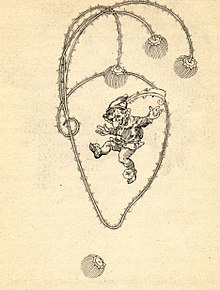
Back كوبولد Arabic Коболд Bulgarian কোবোল্ড Bengali/Bangla Kobold Czech Kobold German Koboldo Esperanto Kobold Spanish Kobold Basque کوبولد Persian Kobold French
 The kobold Heinzelmann | |
| Grouping | Mythological creature Fairy Sprite |
|---|---|
| Country | Germany |
A kobold (occasionally cobold) is a mythical sprite. Having spread into Europe with various spellings including "goblin" and "hobgoblin", and later taking root and stemming from Germanic mythology, the concept survived into modern times in German folklore.
Although usually invisible, a kobold can materialize in the form of a non-human animal, a fire, a human, and a candle. The most common depictions of kobolds show them as humanlike figures the size of small children. Kobolds who live in human homes wear the clothing of peasants; those who live in mines are hunched and ugly and some can materialise into a brick; kobolds who live on ships smoke pipes and wear sailor clothing.
Legends tell of three major types of kobolds. Most commonly, the creatures are household spirits of ambivalent nature; while they sometimes perform domestic chores, they play malicious tricks if insulted or neglected. Famous kobolds of this type include King Goldemar, Heinzelmann, and Hödekin. In some regions, kobolds are known by local names, such as the Galgenmännlein of southern Germany and the Heinzelmännchen of Cologne. Another type of kobold haunts underground places, such as mines. A third kind of kobold, the Klabautermann, lives aboard ships and helps sailors.
Kobold beliefs are evidence of the survival of pagan customs after the Roman Catholicization of Germany or merely that the legends of them have lived on as stories. Belief in kobolds dates to at least the 13th century, when German peasants carved kobold effigies for their homes. Such pagan practices may have derived from beliefs in the mischievous kobalos (pl. kobaloi) (Ancient Greek: Κόβαλος, plural: Κόβαλοι) of ancient Greece which was a sprite, a mischievous creature fond of tricking and frightening mortals, even robbing Heracles/Hercules. Greek myths depict the kobaloi as impudent, thieving, droll, idle, mischievous, gnome-dwarfs, and as funny, little tricksy elves of a phallic nature. Depictions of kobaloi are common in ancient Greek art.[1][better source needed] Other similar sprites include the household lares and penates of ancient Rome, or native German beliefs in a similar room spirit called kofewalt (whose name is a possible rootword of the modern kobold or a German dialectal variant).[2] Kobold beliefs mirror legends of similar creatures in other regions of Europe, and scholars have argued that the names of creatures such as goblins and kabouters derive from the same roots as kobold. This may indicate a common origin for these creatures, or it may represent cultural borrowings and influences of European peoples upon one another. Similarly, subterranean kobolds may share their origins with creatures such as gnomes and dwarves and the aquatic Klabautermann with similar water spirits.
The name of the element cobalt comes from the creature's name, because medieval miners blamed the sprite for the poisonous and troublesome nature of the typical arsenical ores of this metal (cobaltite and smaltite) which polluted other mined elements.
- ^ Kobalos
- ^ Dowden, Ken (2002). European Paganism. Taylor & Francis. ISBN 978-0-203-01177-5.
© MMXXIII Rich X Search. We shall prevail. All rights reserved. Rich X Search